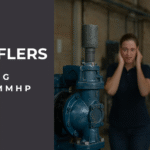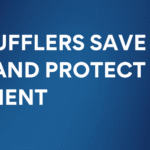Workplace Noise Regulations Made Easy: Stay Compliant with MMHP Pneumufflers®
1. Introduction: Silence, Safety, and the Law
Today, industries are under increasing pressure to meet strict safety and environmental regulations. Governments around the world are focusing more on workplace health, and noise pollution is one of the top concerns.
However, industrial noise, especially from machines that use compressed air, is often overlooked. Many assume that loud hissing or bursting air is normal and harmless. But the reality is far more serious.
Constant exposure to high noise levels can cause hearing damage, reduce focus, and even lead to legal trouble if not addressed properly.
The good news? There’s a simple and effective solution — the MMHP Pneumuffler®.
This blog will walk you through the basics of industrial noise regulations and how using Pneumufflers® can help your business stay compliant, safe, and efficient — all while promoting a better working environment.
2. The Serious Repercussions of Neglecting Noise
The Human Impact
Loud noise in the workplace isn’t just an inconvenience — it’s a health hazard.
Employees who are regularly exposed to high noise levels risk developing Noise-Induced Hearing Loss (NIHL). This condition is permanent and irreversible. It happens gradually and often goes unnoticed until it’s too late.
Besides hearing loss, high noise levels can also cause:
- Fatigue
- Increased stress levels
- Poor concentration
- Communication problems
These issues don’t just affect health; they increase the risk of accidents, especially in environments that rely on clear verbal communication for safety.
The Business Impact
Ignoring noise regulations can hit your business hard.
- Fines and penalties: Government bodies like OSHA (Occupational Safety and Health Administration) enforce strict noise exposure limits. Failing to meet them can lead to expensive fines.
- Legal costs and compensation: If an employee suffers hearing loss or stress-related illness due to noise exposure, you could face workers’ compensation claims and lawsuits.
- Damage to reputation: In today’s world, workers and customers alike care about safety and responsibility. A business known for unsafe practices can quickly lose trust and credibility.
Taking noise seriously isn’t just about following the rules. It’s about caring for your employees and your business.
3. Understanding Noise Regulations: The Key Thresholds
The Decibel Scale Explained
Noise is measured in decibels (dB), which is a logarithmic scale. This means that a small increase in dB actually represents a big jump in noise energy.
For example:
- 60 dB: Normal conversation
- 70 dB: Vacuum cleaner
- 85 dB: Factory noise — this is the legal exposure limit for an 8-hour workday
- 100 dB: Chainsaw or very loud machinery
An increase of just 3 dB doubles the noise energy. So going from 85 dB to 88 dB doesn’t just make things a little louder — it significantly raises the risk of hearing damage.
The 8-Hour Threshold
Most safety agencies, including OSHA, state that 85 dB is the maximum safe noise level for 8 hours of exposure per day.
And here’s the catch: for every 3 dB increase, the safe exposure time is cut in half.
- 85 dB = 8 hours
- 88 dB = 4 hours
- 91 dB = 2 hours
- 94 dB = 1 hour
This shows how even a small reduction in noise — say from 88 dB to 80 dB — can drastically improve worker safety and allow longer exposure without risk.
How Pneumatic Systems Contribute
One of the biggest sources of industrial noise is the sudden release of air from pneumatic systems — such as valves, cylinders, compressors, or air-powered tools.
These exhaust bursts often exceed 90 or even 100 dB, far above the safety threshold.
And because this noise happens frequently and close to the workers, it contributes significantly to hearing damage and non-compliance with regulations.
4. The Pneumuffler®: Your Solution for Compliance
Engineered to Comply
The MMHP Pneumuffler® is specifically designed to tackle this problem.
Its porous design (using materials like sintered bronze or plastic) diffuses compressed air smoothly, reducing exhaust noise to ≤ 80 dB at 1 meter. This level is safely below the legal 85 dB threshold.
By eliminating the sharp “burst” of air and replacing it with a soft whoosh, the Pneumuffler®:
- Helps you stay compliant with noise laws
- Improves employee comfort
- Reduces risk of hearing damage
Versatility in Application
Pneumufflers® can be used in many industries and machines, including:
- Air Compressors: A key source of loud exhaust noise
- Blow Molding Machines: Used in plastic manufacturing — often very noisy
- Pneumatic Motors and Hoists: Constant operation can add up to unsafe noise levels
Wherever you have compressed air being released, you can install a Pneumuffler® to reduce noise without affecting machine performance.
Beyond Compliance: Fostering a Culture of Safety
Using Pneumufflers® does more than just tick a legal box.
It shows your employees and customers that you care about health, comfort, and safety. A quieter environment leads to:
- Better focus
- Fewer distractions
- Higher morale
- A more professional work atmosphere
Companies that invest in safety often see higher employee retention, better productivity, and stronger reputations in their industry.
5. Implementing Your Noise Management Plan
Want to reduce industrial noise in your facility? Here’s a simple step-by-step approach:
Step 1: Audit Your Facility
Use a sound level meter to measure noise at different machines and exhaust points. Identify areas where the decibel levels exceed 85 dB.
Step 2: Choose the Right Pneumuffler®
Based on the machine’s pressure, temperature, and exhaust type, select a compatible Pneumuffler® from MMHP India’s range. Options are available for high-pressure, high-temperature, and standard industrial use.
Step 3: Easy Installation
MMHP Pneumufflers® come with standard BSP or NPT threads, making installation quick and hassle-free. Most units can be installed in just minutes.
Step 4: Monitor and Maintain
Like any safety device, Pneumufflers® should be checked periodically for clogs or wear. A simple cleaning or replacement can ensure they continue working effectively.
6. Conclusion: A Commitment to a Safer Future
Industrial noise is more than a nuisance — it’s a real safety risk. Ignoring it can harm your workers and your business.
Thankfully, the solution doesn’t have to be complicated or expensive.
The MMHP Pneumuffler® is a small, reliable, and cost-effective way to reduce noise, stay compliant with safety regulations, and show your commitment to a safer workplace.
Ready to make your workplace safer and compliant?
Contact MMHP India today to explore our full range of Pneumufflers®. Take the first step toward a quieter, healthier, and more productive environment.





